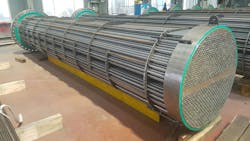Heat Exchanger Solutions for Extreme Operating Ranges in Chemical Facilities
Extreme operating ranges can challenge many different types of equipment. A recent client had an existing heat exchanger that needed to operate with a 100%-25% (4:1) range in product rates, which creates numerous challenges. The exchanger service was cooling a product stream that went to a product tank. The client used cooling water to cool the product.
Failure to cool the product at a high rate would lead to high tank temperatures that could create product quality and safety problems in the tank. Excessive cooling at low rates would cause low temperatures with and increase product viscosity. In fact, with low flow rates and high viscosity, the flow regime in the exchanger could change from turbulent to laminar. With even small flow maldistribution in a heat exchanger, the laminar flow and high viscosity could cause the process fluid in the exchanger to gel or solidify. Regions of the exchanger would be plugged by a waxy solid, increasing pressure drop and reducing overall cooling.
One brute-force solution to this problem is to use two exchangers in parallel. One exchanger would be in service for flow rates from 25%-50% and the second exchanger would be added in parallel to allow for operation in the range of 50%-100%. This setup increases costs by employing two smaller heat exchangers instead of one larger exchanger , along with extra piping and valves. Additionally, either automatic valves are needed to bring the second exchanger on-line or an operator must manually open and close valves. The expected periods of low-rate operation are typically short. But in other situations with extended out-of-service periods for one of the parallel units, special care may be required to avoid dead-leg problems [1].
While extreme low-rate operation would be uncommon, having two parallel exchangers was not optimal since the client sought a system with minimal operator involvement.
Pressure Drop
The client’s requirements created a challenging exchanger problem. If the exchanger was over-surfaced at low rates, the viscosity would rise and potentially create waxy solids. Additionally, even if the duration was short, low velocity could cause substantial fouling [2]. The cooling water rate could be reduced during low rates to help resolve the product viscosity problems, but that might create low-velocity fouling problems on both sides of the exchanger.
If the exchanger had acceptable velocity at the low product rates, pressure drops would be roughly 16 times higher (42) when the rate was four times higher at the high product rates. Also, a traditional arrangement of process on the shell side and cooling water on the tube side would require mechanical features to prevent erosion and elastic vibration problems. Flipping the cooling water to the shell side wouldn’t have helped. The erosion problems would persist with the high process velocity and require special care to avoid channel-head leaks due to high pressure drop.
Solution: A Product Recycle Line
The most practical way to resolve the 4:1 range requirement was to add a product recycle line. Product would be recycled from the exchanger outlet upstream of the pump that sent product to the exchanger. The exchanger would now be configured to operate with the proper velocity at 100% of rates. If rates dropped below 50% or if the outlet temperature dropped too low, a control valve on the recycle line would allow flow to recycle and keep velocities and outlet temperature in the correct range.
Of course, this requires a new line, a control valve station and appropriate control and line changes. When it was operating, the recycle line would also reduce energy efficiency by increasing the relative amount of duty sent to the cooling water system. However, since the duration of the recycle operation would be short, the energy-efficiency loss was tolerable. While not free, the proposed recycle line had a cost acceptable to the client. It also helped reliability in other areas by improving pump operation [3].
While recycle lines can help solve low-flow problems, they do not replace careful thought in setting the flow-rate ranges required. Building for extreme ranges in operating rates imposes costs in equipment, energy efficiency and reliability. That’s why it's crucial to verify the necessity of these fluctuations before incorporating them into the design.
Resources
[1] SLOLEY, A. W. Watch Out for Dead Legs. Chemical Processing. October 2011. Vol. 74, no. 10, p. 48–49.
[2] SLOLEY, A. W., More Exchanger Area Can Pose Pitfalls. Chemical Processing. February 2012. Vol. 75, no. 2, p. 37–38.
[3] SLOLEY, A. W. Kayo cavitation. Chemical Processing. July 2006. Vol. 69, no. 7, p. 51–52.
About the Author
Andrew Sloley, Plant InSites columnist
Contributing Editor
ANDREW SLOLEY is a Chemical Processing Contributing Editor.

